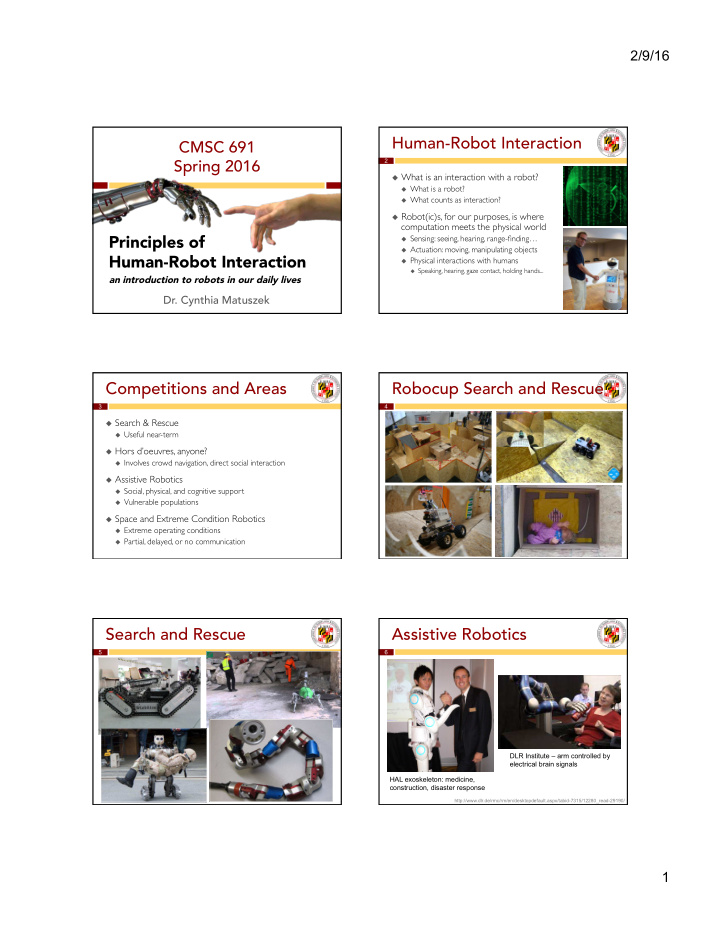



2/9/16 Human-Robot Interaction CMSC 691 Spring 2016 2 u What is an interaction with a robot? u What is a robot? u What counts as interaction? u Robot(ic)s, for our purposes, is where computation meets the physical world Principles of u Sensing: seeing, hearing, range-finding… u Actuation: moving, manipulating objects Human-Robot Interaction u Physical interactions with humans u Speaking, hearing, gaze contact, holding hands... an introduction to robots in our daily lives Dr. Cynthia Matuszek Competitions and Areas Robocup Search and Rescue 3 4 u Search & Rescue u fewkahbfk u Useful near-term u Hors d’oeuvres, anyone? u Involves crowd navigation, direct social interaction u Assistive Robotics u Social, physical, and cognitive support u Vulnerable populations u Space and Extreme Condition Robotics u Extreme operating conditions u Partial, delayed, or no communication Search and Rescue Assistive Robotics 5 6 DLR Institute – arm controlled by electrical brain signals HAL exoskeleton: medicine, construction, disaster response http://www.dlr.de/rmc/rm/en/desktopdefault.aspx/tabid-7315/12280_read-29190/ 1
2/9/16 Assistive Wheelchairs Assistive Wheelchairs 7 8 Chiba Institute of Technology Robust Robotics Group, MIT Assistive Robotics Assistive Robotics 9 10 RIBA-II Transfer Robot Casper Cognitive/Social Assistant Assistive Robotics Social Robotics 11 12 Intelligent System Corporation PARO social robot Leonardo, Personal Robot Group, MIT 2
2/9/16 Types of Interaction Types of Interaction 13 14 Autonomy Interaction u Non-interactive work u Engineering: Directness Low u Still doing tasks for humans u Building, maintaining, (re)programming Low u Teleoperating u Teleoperating u Supervising u Supervising There are a u Correct errors, give low-level instructions u Correct errors, give low-level instructions number of formal autonomy scales! u Providing goals u Providing goals u From “Pick up the block” to “Cook dinner” u From “Pick up the block” to “Cook dinner” u Non-supervisory interactions u Non-supervisory interactions u With people u With people High High u In environments (e.g., cleaning) u In environments (e.g., cleaning) System Design Autonomy 15 16 u How autonomous should this robot(s) be? u How autonomous should this robot(s) be? u For what kind of interaction? u What kind of group is the robot in? u What is the target problem(s)? u Other robots? Humans? u Are their human collaborators? u How is it structured? Who’s in charge? u Partial; full; social; correctable; haptic; feedback; … u Information management u What kind of autonomy? u Who knows what? Is it transferred? u Goal-based In practice, these are incredibly u How adaptive or predefined is the task? u Behavior-based high-level simpli6ications of all of arti6icial intelligence – but useful! u What is is the e task sk or or task sk doma omain in? u Probabilistic Information Exchange Information Exchange (II) 17 18 u Who knows what? Who needs to know what? u The medium u Seeing u When information transferred: Many human- u Hearing robot u When exactly? u Touch interactions u From whom to whom? can also be u How slow? How costly? human- u How information is transferred: human, robot- “Put the pot here robot, or a u Using what media? and hand me the sugar, please” more complex u In what format? (Scripted, one-way, free?) OKAY mix. This is u Do you need a cognitive model � why I often of the agents? say agent . 3
2/9/16 Group Makeup Adaptation 19 20 u Humans and robots u What can be learned? u 1-1, many-many, 1-many, many-1, 1-0, 0-many, … u Task domain; task actions u Related to autonomy, task u Changes over time u Communication style and kind u Who has authority? Who has responsibility? u Authority and communication flow u When does the human not have pure authority? u What can change? u Timing? Task-based? u The task? The authority? Agent capabilities? u What is optimal? u Over what span of time? u In response to what information? u What agent(s) should do the learning? Autonomy Authority Practical Discussion 21 u Search & Rescue u Autonomy u Hors d’oeuvres, anyone? u Group Structure u Assistive Robotics u Information exchange u Transfer u Social u Adaptation and u Wheelchair Learning u Space/Extreme Conditions u Surgical 4
Recommend
More recommend